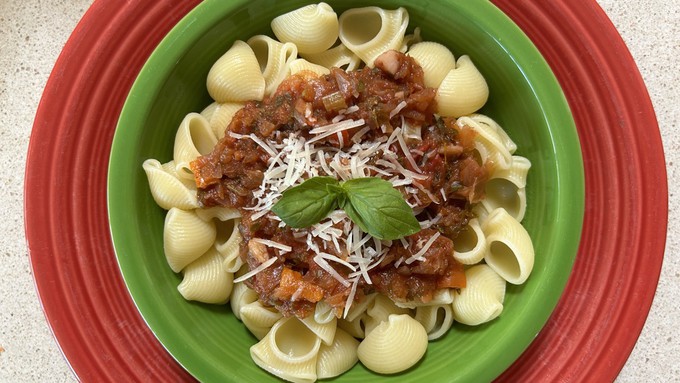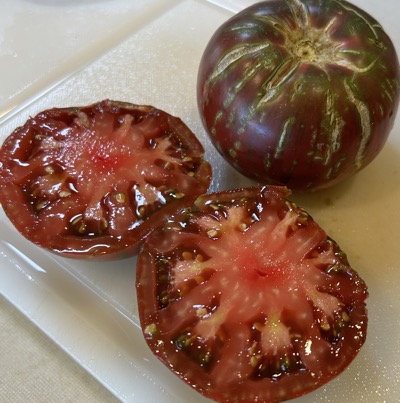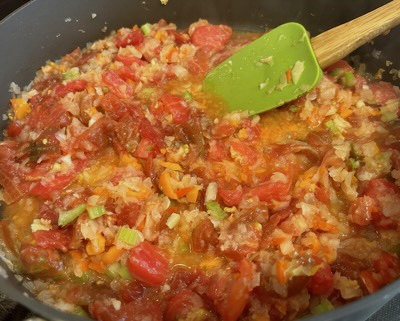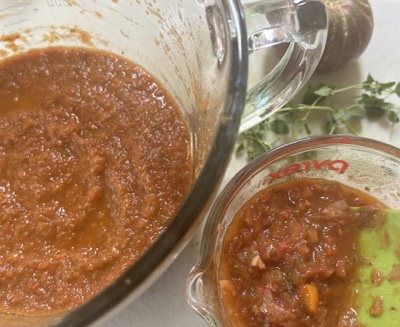
Recipe: Chunky or smooth, it's the fresh flavor of summer

Garden sauce is a perfect summer topping for pasta, gnocchi or grilled polenta. Blend it or leave it chunky, as desired. Kathy Morrison
This recipe is not for canning, not even for freezing. It uses those homegrown tomatoes that are ready NOW, ones bursting with juice and flavor, and may already have burst, thanks to the summer heat.

I'm a longtime tomato grower, and developed this recipe years ago under just those circumstances, with dead-ripe slicing tomatoes that had to be used immediately. Any color tomato works, though I like to use a mix. The one here is a blend of several Pink Berkeley Tie-Dyes and a 1-pound-plus Brandy Boy.
I remove most of the tomato skin and seeds, but am not obsessive about it. They're not noticeable in the sauce when it's blended, and they become part of the texture if it's left chunky.
The sauce incorporates fresh herbs, too, especially basil. Italian oregano and parsley are good, too; I add some thyme because I have it.
Ladle the sauce on top of freshly cooked pasta, grilled polenta or any quick gnocchi. It's the taste of summer, distilled in one dish.
Kathy's Garden Sauce
Makes about 3 cups
Ingredients:
1 large yellow or white onion, trimmed and skinned
Half of a large red or orange bell pepper, or 2 to 3 small ones, cored and seeded
1 tablespoon olive oil
3 to 5 garlic cloves, minced
1 stalk celery, chopped
3 to 4 cups fresh tomatoes, cored, peeled and seeded, then chopped roughly
Sea salt and freshly ground black pepper
1/2 cup hearty red wine, such as zinfandel or primitivo, divided

Large handful of fresh basil leaves, a few reserved for garnish
5 or 6 sprigs fresh oregano, leaves stripped off
3 or 4 sprigs fresh thyme, optional, leaves stripped
4 or 5 sprigs parsley, flat or curly
Cooked pasta, gnocchi or polenta, for serving
Grated Parmesan cheese, for serving
Instructions:
Chop the onion and bell pepper; I put them together in my food processor, but a rough hand-chop is fine.
Heat the olive oil over medium-high heat in a large saucepan or skillet. Add the onion, bell pepper, garlic and celery, and sauté until the onion is soft but not brown. Stir in the tomatoes, then add a few pinches of salt and a few grinds of pepper. Lower the heat and let the sauce simmer until it starts to thicken slightly.
Stir in 1/4 cup of the wine, turn the heat back up until the sauce bubbles, then reduce heat and cover the pan. Cook for about 10 minutes. Meanwhile, chop the herbs together. Remove the pan's cover and stir in the prepared herbs. Add a pinch more salt and pepper, and continue cooking until the flavors blend. (If the sauce gets too thick at any point, stir in the rest of the wine.) Taste and correct seasonings before serving.

If smooth sauce is desired, remove the sauce from the heat and let it cool for a few minutes. Blend it in a bowl using an immersion blender, or place in the container of a standard blender, and then blend. If it seems too thick, adding a bit more wine or some hot water works well. Or, if you're cooking pasta to go with the sauce, 1/4 cup or so of starchy pasta water is an excellent thinning liquid.
Serve sauce with desired accompaniment, garnished with shredded Parmesan and basil sprigs, if desired.
Comments
0 comments have been posted.Sacramento Digs Gardening to your inbox.
Sites We Like
Garden Checklist for week of July 21
Your garden needs you!
* Keep your vegetable garden watered, mulched and weeded. Water before 8 a.m. to reduce the chance of fungal infection and to conserve moisture.
* Feed vegetable plants bone meal, rock phosphate or other fertilizers high in phosphate to stimulate more blooms and fruiting. (But wait until daily high temperatures drop out of the 100s.)
* Don’t let tomatoes wilt or dry out completely. Give tomatoes a deep watering two to three times a week.
* Harvest vegetables promptly to encourage plants to produce more. Squash especially tends to grow rapidly in hot weather. Keep an eye on zucchini.
* Pinch back chrysanthemums for bushy plants and more flowers in September.
* Remove spent flowers from roses, daylilies and other bloomers as they finish flowering.
* Pinch off blooms from basil so the plant will grow more leaves.
* Cut back lavender after flowering to promote a second bloom.
* It's not too late to add a splash of color. Plant petunias, snapdragons, zinnias and marigolds.
* From seed, plant corn, pumpkins, radishes, winter squash and sunflowers.